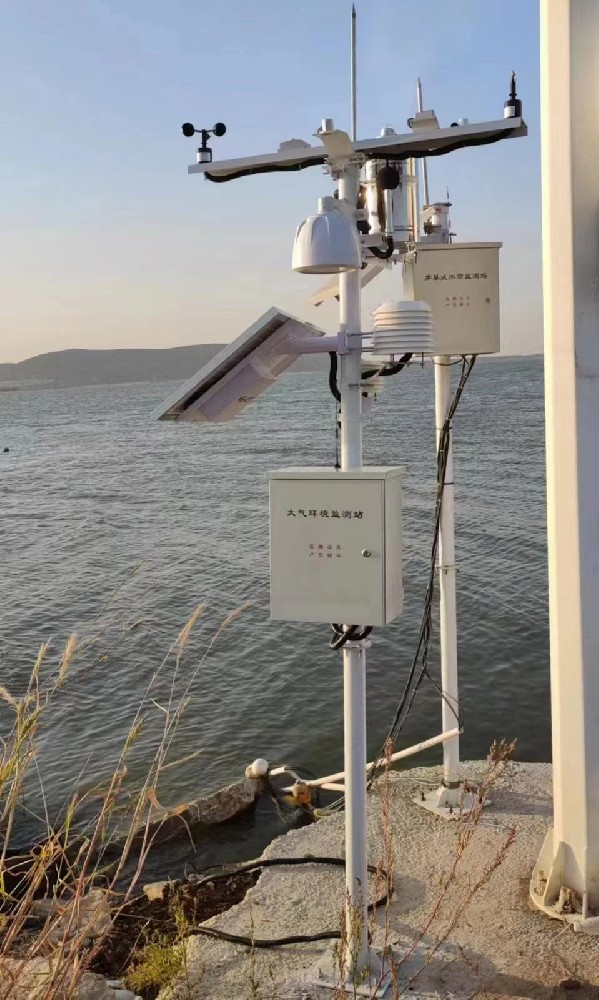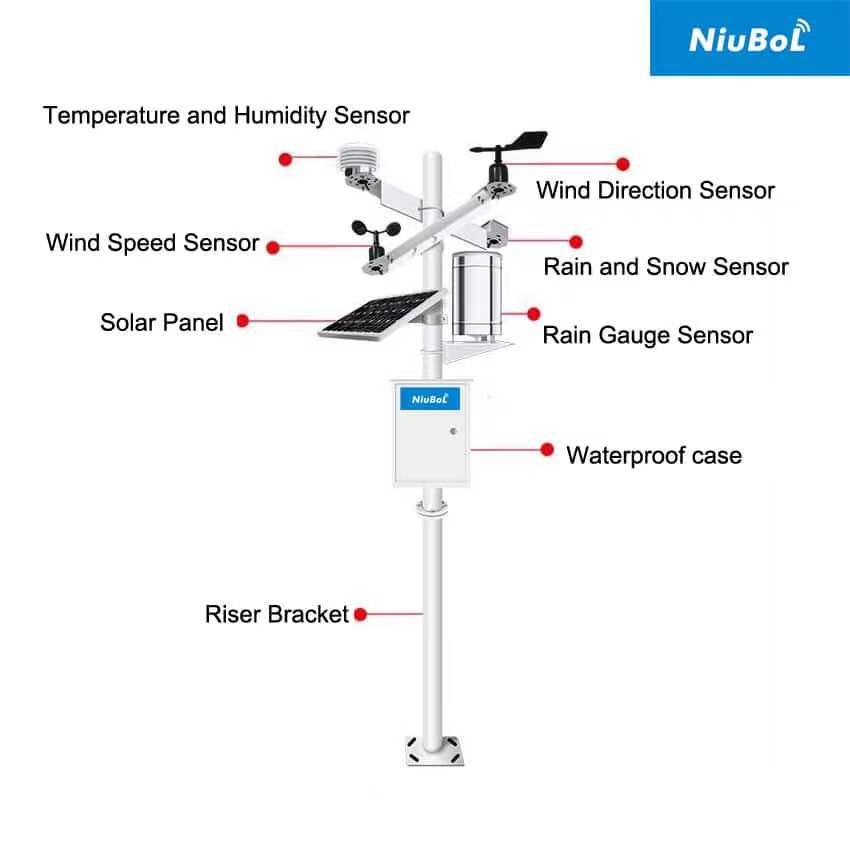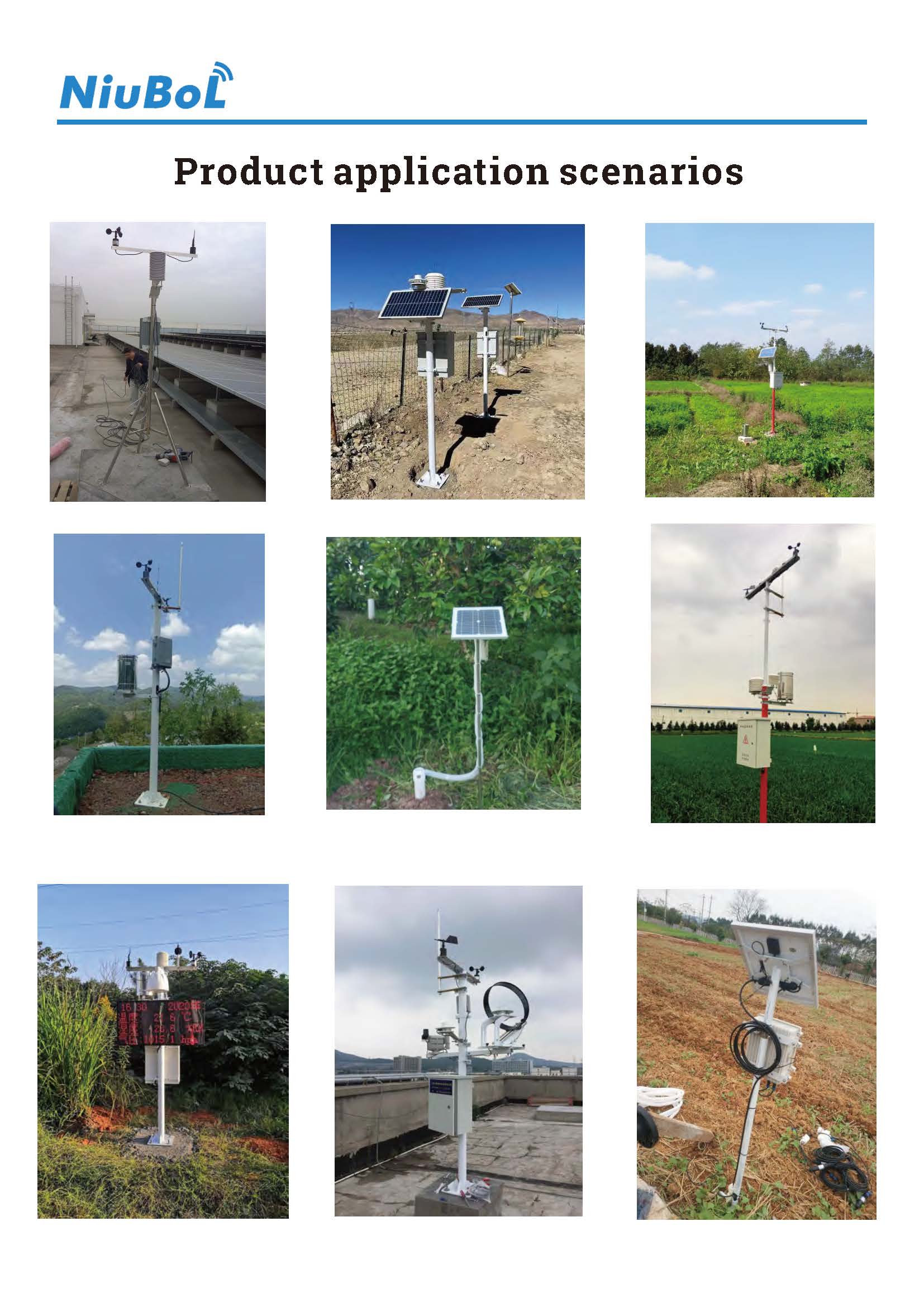

— Blogs —
—Products—
 Consumer hotline +8618073152920
Consumer hotline +8618073152920 WhatsApp:+8615367865107
Address:Room 102, District D, Houhu Industrial Park, Yuelu District, Changsha City, Hunan Province, China
Product knowledge
Time:2025-11-21 14:41:50 Popularity:96
Automatic weather stations (AWS) have become one of the most important infrastructures in global meteorological observation systems. With highly automated observation capabilities, stable and reliable data output, and strong environmental adaptability, they provide indispensable support for weather forecasting, climate research, agricultural management, and disaster prevention.
NiuBoL automatic weather stations are renowned for their professional-grade sensors, industrial-grade construction, and intelligent platform capabilities, and are widely used by research institutions, agricultural departments, environmental agencies, and industrial facilities worldwide.
The heart of an automatic weather station lies in its sensors — an “instrumented sensory system” that captures atmospheric information in real time through physical-to-electrical conversion technology.
Uses platinum resistance (Pt100/Pt1000) or digital temperature chips to measure temperature via changes in electrical resistance.
Role: Provides continuous, precise temperature data — foundational for weather forecasting, agriculture, and environmental monitoring.
Based on capacitive humidity-sensitive film; dielectric constant changes with moisture absorption and is converted into relative humidity (%).
Role: Essential for predicting precipitation, fog, haze, and human comfort indices.
Employs MEMS technology; measures atmospheric pressure through the deflection of a silicon diaphragm.
Role: Sudden pressure changes often signal weather system shifts — a critical parameter for short-term forecasting.
Available in three-cup or ultrasonic designs:
- Three-cup type calculates speed from rotation rate
- Ultrasonic type measures wind speed via time-of-flight differences in sound waves
Role: Vital for high-wind and typhoon warnings and wind energy assessment.
Mechanical vane with internal magnetic encoder or multi-axis ultrasonic measurement.
Role: Determines air mass movement and pollutant dispersion direction.
Typically tipping-bucket design: rainwater fills one side of the bucket, which tips when full, triggering a count for a fixed volume.
Role: Measures precipitation amount, classifies heavy rain events, and supports hydrological analysis.
In addition to sensors, a mature NiuBoL automatic weather station includes:
The central processing unit that:
- Collects real-time multi-channel sensor data
- Stores and backs up data
- Parses protocols (Modbus, RS485, etc.)
- Performs automatic validation and error correction
Supports RS485, RS232, 4G/5G, LoRa, WiFi, Ethernet, etc., ensuring stable data upload even in remote areas.
Power Supply System
- Solar panels + battery (most common)
- AC mains power
- Dual redundant power backup
Surge protection modules, grounding systems, and IP65/IP67 waterproof enclosures for long-term outdoor use in extreme weather.
Mounting Tower and Accessories
2–10 m mast, flange base, stainless steel fixtures, and sensor arms — all compliant with industry installation standards.

- Data visualization (line charts, wind rose diagrams, real-time curves)
- Data export and API access
- SMS/email alerts
- Centralized multi-site management
Core Advantages of Automatic Weather Stations
- Fully Automated, Unattended Operation
24/7 continuous operation with automatic data collection, upload, and alerting — significantly reducing maintenance costs.
- High Accuracy and Long-Term Stability
Industrial-grade sensors with auto-calibration, temperature compensation, and anti-interference design ensure reliable data over years.
- Real-Time Transmission and Rapid Response
Data can be pushed to the cloud within seconds, providing critical time for nowcasting and disaster warnings.
- Strong Adaptability and Scalability
- UV radiation, solar irradiance sensors
- Automatic evaporation pans
- Soil moisture/temperature sensors
- Combined water quality and meteorological stations
Suitable for diverse climates, regions, and monitoring tasks worldwide.
Provides data for official forecasting, climate studies, and model validation.
Guides irrigation timing, pest/disease risk alerts, and microclimate analysis.
Rainfall and wind data are critical for reservoir operation and flash flood warnings.
Runway weather monitoring and highway visibility/road condition systems.
Wind farms, solar plants, and chemical parks use real-time data to enhance safety and efficiency.
Supports urban heat island studies, haze dispersion analysis, and emergency response.
Used for teaching, science outreach, and student research projects.

Automatic stations operate 24/7 without human intervention, delivering more continuous and timely data suitable for digital platforms.
Yes — NiuBoL sensors meet or exceed national and international standards, suitable for scientific, meteorological, agricultural, and industrial applications.
Yes — IP65/67 protection, lightning surge protection, and wide-temperature electronics enable reliable operation from -40°C to +80°C in storms and heavy rain.
Supports RS485, RS232, 4G/5G, LoRa, WiFi, and Ethernet — the most stable option can be selected based on local conditions.
Only an open location, simple foundation, and solar or mains power are needed — no complex construction required.
Yes — supports CO₂, solar radiation, soil moisture, PM2.5/PM10, and many other sensors via standard protocols.
Yes — supports API, Modbus, Excel export, and integration with government, agricultural, or SCADA systems.
Maintenance is minimal (periodic cleaning and inspection), consumables are few, and solar-powered systems operate reliably for years at very low cost.

With its automation, intelligence, and professional-grade data capabilities, the NiuBoL automatic weather station has become indispensable equipment in modern meteorological monitoring systems. Whether for national meteorological services, agricultural production, hydrological safety, industrial applications, or urban management, it delivers accurate, stable, and continuous data support.
Choosing a reliable automatic weather station means laying a solid foundation today for tomorrow’s scientific decision-making, production management, and safety early warning.
NiuBoL will continue to provide trusted meteorological monitoring solutions to industries worldwide through high-performance sensors, powerful platform capabilities, and global service support.
Related recommendations
Sensors & Weather Stations Catalog
Agriculture Sensors and Weather Stations Catalog-NiuBoL.pdf
Weather Stations Catalog-NiuBoL.pdf
Related products
 Combined air temperature and relative humidity sensor
Combined air temperature and relative humidity sensor Soil Moisture Temperature sensor for irrigation
Soil Moisture Temperature sensor for irrigation Soil pH sensor RS485 soil Testing instrument soil ph meter for agriculture
Soil pH sensor RS485 soil Testing instrument soil ph meter for agriculture Wind Speed sensor Output Modbus/RS485/Analog/0-5V/4-20mA
Wind Speed sensor Output Modbus/RS485/Analog/0-5V/4-20mA Tipping bucket rain gauge for weather monitoring auto rainfall sensor RS485/Outdoor/stainless steel
Tipping bucket rain gauge for weather monitoring auto rainfall sensor RS485/Outdoor/stainless steel Pyranometer Solar Radiation Sensor 4-20mA/RS485
Pyranometer Solar Radiation Sensor 4-20mA/RS485
Screenshot, WhatsApp to identify the QR code
WhatsApp number:+8615367865107
(Click on WhatsApp to copy and add friends)
